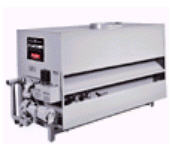Energy Audit Water Heating Systems
 Overview
Overview
For the basics on water heating, see Water Heating
Audit Approach
Water heating can be the ‘low hanging fruit’ of many energy audits, at least for facilities that use a lot of hot water. Standard water heaters are relatively inefficient and most systems were not designed for energy efficiency. As with any audit, the starting point is to identify existing water heating equipment, gather as many ‘facts’ as possible, and estimate heated water usage. But, before putting too much effort into gathering data, it is important to first approximate how important water heating is based on what percentage of energy usage in the facility is represented by heating water. For example, if the facility is a large office building, but the water heater is only used to provide hot water for hand washing and light cleaning, then it won’t justify spending much time on it. On the other extreme are hotels, food processors, laundries and other industrial processes such as parts washing, that use large volumes of hot water. Both the cost of the water and heating it should be considered. In some areas, water costs may be a bigger motivator to conserve than heating costs.
The primary categories to consider are:
- Reduce Hot Water Usage
- Reduce Standby and Distribution Temperature Losses
- Produce Hot Water More Efficiently
Reducing hot water usage includes Measures such as low-flow shower heads/ faucets and making process changes like adding more filtration to reduce water make-up requirements.
Reducing standby and distribution losses includes Measures such as reducing water temperature set-points, shutting off circulation pumps during unoccupied periods, adding insulation to pipes and storage tanks.
To produce hot water more efficiently, consider replacement high-efficiency water heaters, direct contact water heaters and producing hot water from other “waste” energy sources, such as a high temperature furnace exhaust.
Estimating Savings
Water is the basis for the definition of a BTU. 1 BTU = the amount of energy it takes to raise 1 pound of water, 1 degree Fahrenheit. Since water weighs about 8.34 lbs/gallon, every gallon of water raised 1F requires 8.34 BTUs.
For Example: 1,000 gallons of water per hour is heated from 50F to 140F, 8 hours per day, 5 days per week.
1,000 gallons x 8.34 lbs/gallon x (140F – 50F) x 8 hours = 6,004,800 BTUs per day
If the water heater is 70% efficient, then the input fuel requirement is 6,004,800 / 0.70 = 8,578,286 BTUs per day
CAUTION: Water is typically referenced in Gallons Per Minute, GPM. Be sure to include the factor of “60” when working with GPM versus Hourly data.
If replacing the water heater/boiler, consider the efficiency improvement applied to the entire hot water usage. ie: Estimate the total cost to heat water with the existing system, and take a percentage based on the efficiency of the new unit.
“Free” Hot Water
Is there an existing source of “waste” heat that could be used to pre-heat hot water? Facilities with ovens, furnaces, emissions control equipment (RTO, CTO, etc.), large air compressors, on-site power production, or plans to install such equipment may have a source of ‘free’ heat that could be recovered to heat water. Things to consider for such an application include:
- Location of heat in relation to location of needed hot water; long piping runs are expensive to install and increase operational costs for pumping and system losses even when well insulated.
- Hours of operation and total hours of availability of heat in relation to need; if the heat is available continuous, but the need is only for a couple of hours, storage tanks can be added but will increase the installation costs
- What is the temperature of the heat source? Low-grade sources, such as air compressors, can use less expensive heat recovery systems than high-temperature sources such as a heat treat furnace, but may not provide as much total heat.
If the application appears to have a good fit/match, gather as much information as possible, and then contact a local vendor of heat recovery equipment for assistance. Waste heat recovery systems tend to be highly customized. Although it may use ‘off-the-shelf components’, careful design is required for best operation and economics.
More Information
Waste Heat Recovery High Temp Air
Economizers and Flue Gas Condensers
Source: Text Bob Fegan 1/2009;
© 2008 Energy Solutions Center400 N. Capitol Street NWWashington, DC 20001 All rights reserved. Legal Contact our webmaster
